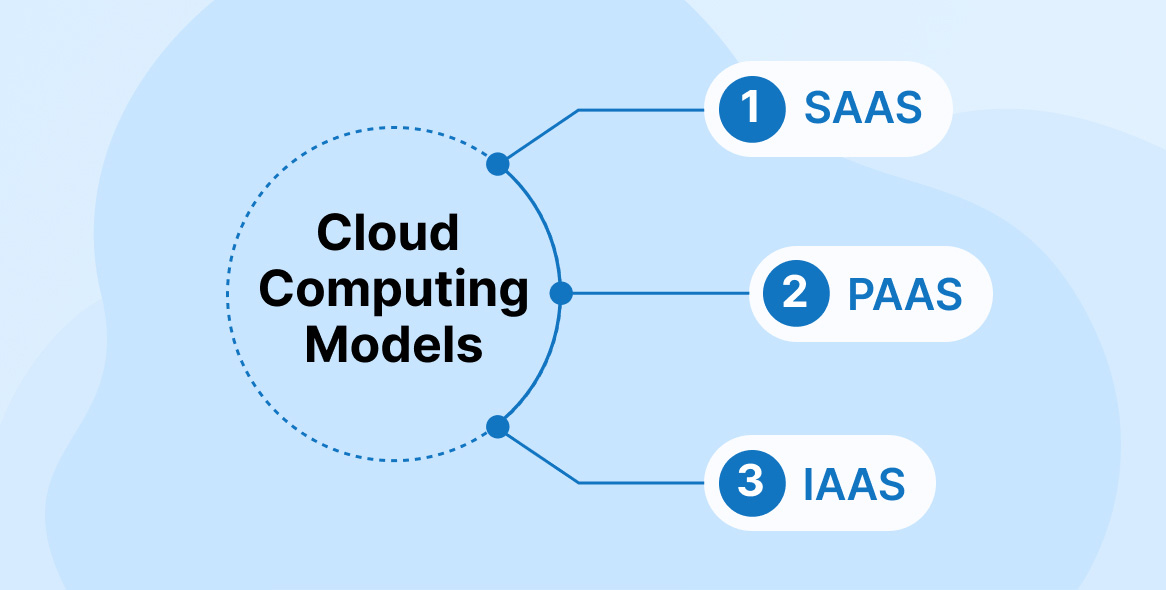The cloud concept is no longer entirely enigmatic."Different Types Of Cloud Computing Solutions" Every facet of digital transformation and contemporary technology is rife with this phrase, which we have come to accept as the reality of daily life, even if the effects of the cloud change are yet unknown. However, our ignorance of cloud infrastructure and what it offers leads us to undervalue this fundamental technology. And to really value the cloud, one must have a better understanding of cloud computing: what is it and how does it work?
Comparing Various Cloud Computing Solutions
What is computing in the cloud?
A few years ago, the fundamental premise of the cloud was discounted as "someone else's PC," a phrase that fits quite a few IT experts' coffee mugs. Equally dubious was Oracle CTO Larry Ellison, who objected that "we have defined cloud computing to cover everything we already do." Said another way, the basic definition of cloud computing is this:
And even though there are various ways to describe cloud computing, these five main points define it all:
- Storage,
- data management,
- networking,
- devices
categories of cloud services
Cloud computing services are a fast-growing, multibillion-dollar market. Gartner projects that by the end of 2018, cloud expenditures will have totaled $260 billion. Gartner is not the only one highlighting the rising market share of cloud computing. Based on their 2017 Cloud Vendor Revenue Projection Project, Wikibon projects that from 2016 to 2026, all categories, including business cloud, would increase at a compound annual growth rate (CAGR) of 19 percent. Instead, on-premise software, legacy approaches to business process outsourcing, and conventional infrastructure will have a negative 3 percent CAGR. The three broad, widely used, and ubiquitous forms of cloud computing services—software-as-a-service (SaaS), infrastructure-as-a-service (IaaS), and platform-as-a-service (PaaS)—show the dynamic consequences of cloud adoption most clearly.
1. Software-as-a-Service
Usually referred to as "on-demand software," SaaS is the most often used cloud computing tool available to corporate users. Among the many application and service types, SaaS is replacing or augmenting traditional enterprise systems, including ERP, accounting, human resources management, content management systems, supply chain and inventory management, and customer relationship management (CRM) programs, among others. Users of SaaS can use many cloud apps as required without having to buy a pricey licensed package. The typical company has 16 SaaS apps installed, a 33 percent increase over the year, according to the 2017 State of the SaaS-Powered Workplace Report. For more SaaS-related information, check out our top SaaS FAQ compilation.
2. Platform-as-a-Service
PaaS sits at the at the center and links SaaS and IaaS, so consider it the intermediary of cloud services. Users of this cloud service have all the tools required to build a digital platform. It integrates, analyzes, and shares data to offer the foundation for storage, networking, and virtual servers with the hardware and software required to design, develop, test, implement, manage, and run applications.
3. Infrastructure-as-a-Service
The IaaS layer offers essential building blocks, database storage, and a virtual platform. Building scalable and affordable IT solutions lets complicated and costly hardware be outsourced to a third-party cloud vendor. For consumers able to self-provision the storage or processing capacity of the IaaS platforms, all of these IT components are automated. Ongoing maintenance—including system upkeep, data backup, and business steadiness—is also the responsibility of vendors.
Read also: The 2024 Social Media Strategy That Gets Results
Sort of cloud installations
The way a company uses its cloud service will show how well it manages and locks in corporate assets and needs. However, cloud deployment goes beyond the "private cloud vs. public cloud" argument. The emergence of hybrid cloud deployment brings a rather distinct taste.
1. public cloud
Third-party IaaS cloud providers help to sustain a public cloud. Online delivery brings servers, storage, and other digital resources. The supplier absorbs all infrastructure and bandwidth expenses; hence, a client simply requires a web browser to access services and handle accounts.
2. Private clouds
Operating just under an organization independent of other businesses or public platforms, cloud computing services, infrastructure, and networking are housed in a private cloud. A company's data center is physically housed in-house, or a third-party vendor is paid to host everything on a private instance—a private cloud can be managed in either one of two ways.
3. Mixed Cloud
As one might expect, a hybrid cloud deployment combines public and private clouds. This architecture lets apps, data, and information be shared and swapped out interchangeably. While the public side may execute high-volume applications, the private side can be utilized for delicate operations such as finances and data recovery.

Leading cloud computing companies
Without continuous developments in cloud computing, none of the biggest and most well-known digital companies could exist. With never-ending one-upmanship and massive strategic SaaS, PaaS, and IaaS installations, the leading cloud computing businesses have indeed developed what is known as the "cloud wars." And thus far, the two companies below have grabbed front stage in commanding the IaaS cloud industry.
Microsoft: Deeply committed to all three tiers of the cloud, Microsoft cloud computing—with its Microsoft Azure and Dynamics 365 products—remains the top worldwide enterprise cloud provider. Around artificial intelligence (AI), machine learning (ML), and blockchain, Microsoft is creating and releasing products. More than half a billion dollars ahead of any other cloud computing provider, the firm made a $6 billion profit in Q1 this year.
Read also: 8 Steps To Mastering Social Media Marketing
Advantages of cloud computing
The corporate environment of today depends more and more on devices having Internet of Things capabilities (particularly tablets and smartphones). Most offices are, therefore, basically turning into virtual offices. Cloud computing therefore allows simpler and more effective access to data. Cloud computing is clearly having a substantial commercial impact, according to a new Vanson Bourne market research report. Businesses that have embraced cloud services have witnessed a 20 percent rise in company growth, a nearly 21 percent boost in time to market, and a 19 percent leap in process efficiency. These even greater benefits of cloud computing come from:
- Flexible costs: While most cloud spending is operating expenditure (opex), flexible costs: cloud computing flips the table on traditional capital expenditure (capex). A third-party vendor will handle maintenance, so a corporation does not have to pay for a support staff to address issue servers. Infrastructure needs, like local server purchases, have lower upfront expenses.
- Enhanced mobility: apps and data are available anywhere, anytime, via the cloud. And that's all because of the always rising count of cellphones and tablets, among other mobile gadgets. The "anywhere, anytime" advantage also very definitely relates to business. Workers get freedom and improve their efficiency in customer service and process execution.
- Increased collaboration: Cloud computing is basically designed to improve work operations, hence data flows between company partners and colleagues. Companies want additional applications for simplified procedures and file sharing. Remote workers can quickly interact and contact essential clients as well as fellow staff members.
- Economies of Scale: Using economies of scale helps cloud computing lower costs. For a 1000-server deployment, a Booz Allen Hamilton analysis revealed the cloud strategy may save expenses by 50 to 67%. Reduced expenditures in on-site infrastructure result from cloud consumers using providers' economies of scale to take advantage of reduced prices.
- Operational:Though some are just less complicated, technology will never be flawless. That covers the infrastructure of cloud computing, which often operates on separate servers via an outside provider. Therefore, when issues do develop, it is the vendor's responsibility to quickly address them rather than allowing on-site IT professionals to spend time and funds upgrading servers or filing claims.
Disadvantages of Cloud Computing
That is not to argue, though, that cloud computing has flaws (remember: technology will never be flawless). Though small, there will still be some degree of downtime; again, leaky security and a data breach are always possibilities. Though cloud computing has its drawbacks, they are not all hopeless. One can reduce hazards in several ways.
1. Outage
Third-party cloud service providers may have technical issues and become overwhelmed with too many customer demands as more businesses rely on them. A company can stop with unavailable applications, data, and servers, just as any cloud-related outage or interrupted internet connection would.
2. security
Not entirely free from having their data hacked are even the largest and most well-known companies with the finest security policies. Furthermore, keeping sensitive, valuable data on external service clouds is not a perfect solution either. Particularly in public clouds, where accessibility is widely exposed to hackers, negligent users, and other vulnerabilities, there are always weaknesses in sensitive systems.
3. Restricted management
Much conventional IT maintenance is offloaded by the cloud service. Less control over the IT process follows from this, though. A firm's application leader will only have access to frontend management tooling for applications, services, and data—not backend infrastructure.
FAQs: Different Types Of Cloud Computing Solutions
What are the different types of cloud solutions?
Public clouds, private clouds, and hybrid clouds comprise the three basic forms of cloud computing. Four key services— Infrastructure as a Service (IaaS), Platform as a Service (PaaS), Software as a Service (SaaS), and Serverless Computing—exist inside these deployment methods.
What are the 4 cloud computing services?
These build on one another, so they are frequently referred to as the "stack" for cloud computing. Knowing their nature and differences helps you to achieve your company objectives more easily.
4 Types of Cloud Networking
- Public cloud networking.
- Private cloud networking.
- Hybrid cloud networking.
- Multi cloud networking.
What is cloud computing and types?
Using the internet to access databases and networks kept on far-off servers is the essence of cloud computing. Software-as-a- Service, Infrastructure-as-a-Service and Platform-as-a- Service are three forms of cloud computing.







